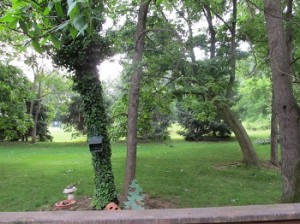(This essay is one in a series of pieces about what I am reading during National Short Story Month 2011. To see a list of the stories, visit What I’m Reading During National Short Story Month 2011.)
May 29, 2011
Sunday
The lists . . . are written on all kinds of paper: lined tablet, milk-order forms, old envelopes, the backs of grocery bills. . . . Such a lot of things for him to do, that have to be done, inside and outside. . . . The house demands perpetual care. Washing, painting, seasonal chores, restless furniture. . . .Â
               — Julie Hayden, 1939-1981
                    American fiction writer and editor
                    from “The Stories of the House” in The Lists of the Past, The Viking Press, 1976
 Today marks the 35th anniversary of the day I moved into this house. I had been married just under six months. We’d been living in a cramped, poorly-designed three-room apartment that I had moved to after a dispute with the new owner of the place I’d lived in for five years. He’d raised the rent, lowered the temperature on the hot water heater, and put a little cage around the thermostat, so that during my last winter there I shivered most of the time. No wonder I signed up for an evening adult ed class at the community college.
Today marks the 35th anniversary of the day I moved into this house. I had been married just under six months. We’d been living in a cramped, poorly-designed three-room apartment that I had moved to after a dispute with the new owner of the place I’d lived in for five years. He’d raised the rent, lowered the temperature on the hot water heater, and put a little cage around the thermostat, so that during my last winter there I shivered most of the time. No wonder I signed up for an evening adult ed class at the community college.
I remember that time now as a howling void of unbearable loneliness. I carried around a gnawing depression, convinced that my life was going nowhere but unable to change its course. As I’d heard Etta Place say in Butch Cassidy and the Sundance Kid, a movie I saw on the 5-inch black and white television that had been a gift from the boyfriend who’d abandoned me, “I’m 26, and I’m single, and a school teacher, and that’s the bottom of the pit.” Except I was 28, and there was no one remotely like Robert Redford in my life. Another evening student, recently discharged from the service and using his GI Bill benefits to try to decide what to do with his life, struck up a conversation with me in the snack bar that first night, and the second night, and two months later we were engaged.
We stayed married seven years, and the worst I can say about it is that it was boring. I learned to live with and compensate for his alcoholism and his inability to manage money. Specifically, I kept our savings passbook in my desk at school— this was in the days before you could clean somebody out with an ATM card — kept the bare minimum in the checking account, and found things to do during the hours he spent at Brothers Brown Bar, a site notorious as the source of more than half of the police calls in Susquehanna Township. When he left me for someone else, it was mostly a matter of paperwork to sever our lives, and, through circumstances too complicated to go into here, I kept the house. It’s where my second bridegroom came to build a life with me, where we raised our daughter, where I grew into the woman I am today.
One of the things I did, especially in the early years, to both save money and find something to do was to escape into fiction, much of it borrowed from the public library. It was a library copy I used that summer of 1976 to read The Lists of the Past, a slim volume of a dozen stories by Julie Hayden, an editor at The New Yorker who, the jacket copy said, was “at work on a novel.” I was no doubt attracted by the title, and by Brendan Gill’s blurb on the cover that promised I would find “at least one sentence that even the most cynical of readers will be unable to finish without tears.”
I’ve written about this author and this book before. In 2008, I reposted an old list of things to write about, and recalled being attracted to Julie Hayden’s title, and wondering what had become of her. That’s when I learned that she had died in 1981, before she was 43 and before she had produced that novel her debut collection had promised. Last November I took a used copy I acquired some years ago with me to the Vermont Studio Center, and wrote “Breathe Into the Balloon” as a response to one of the stories. And I knew I had to go back to that collection today, the anniversary of the beginning of my long tenure here, for a selection for National Short Story Month.
The book’s twelve stories are divided into two groups. Brief Lives gives five independent stories, including “Day-Old Baby Rats.” In 2010, fiction writer Lorrie Moore read that and commented on it for a New Yorker podcast. Interest in Julie Hayden’s out-of-print collection spiked, and the price of a used copy of the book shot up on booksellers’ sites to more than a hundred dollars. (I am not willing to part with mine, acquired for about $10 before the gold rush.) The six stories in the second half of the book are grouped under the heading The Lists of the Past. These are connected stories that give us a family and a house and a suburban milieu that together are an early example of one of today’s popular genres, the novel-in-stories or the linked story collection. (Elizabeth Strout’s Olive Kitteredge, which won the Pulitzer in 2010, and Dylan Landis’s Normal People Don’t Live Like This are examples of this trend.) Julie Hayden was, apparently, way ahead of her time.
The six connected stories chronicle the illness and death of the owner of a house built before the Civil War in a location not unlike West Egg, the Long Island suburb that dominates the scenario of The Great Gatsby. Once the guest cottage on a large estate, it has three stories, more than a dozen rooms, a front staircase “a girl would be proud to throw her bouquet from,” back stairs, basement workshops, even a space thought to have been a stop on the Underground Railroad, where a sojourning slave could rest in safety on his journey to freedom. The house and the extensive grounds require constant work, “perpetual care,” and the owner, Ben, is never without thought and concern for what has to be done next, what might have been left unfinished. The house is personified, described as having a memory (the attic), a stomach (the kitchen), eyes (the windows), and lungs (the heating and air-conditioning apparatuses), and by the last of the stories, the reader sees that the house and the owner are one, that the family he raised there and the work he undertook to make their lives comfortable as they grew into their best selves are his identity, his best self.
Moving is a strenuous, stressful undertaking, even when you have only three rooms’ worth of possessions. By the end of the day on May 29, 1976, I was exhausted. Due to poor communication on the part of the builder, one of the rooms had not been carpeted. A thermostat in the kitchen malfunctioned and was pumping out heat despite its being turned off and the day being humid. The bathtub leaked, causing a section of the kitchen ceiling to collapse and requiring that we live with that and the shiny cement floor in the uncarpeted room for the two weeks it took for the situation to be remedied.
Late in the afternoon, after the movers had left, the contractor been summoned to survey the problems and make arrangements to correct them, and customer service at John Wanamaker contacted to inquire about where my kitchen table and chairs might be (they’d gone to the wrong Bradley Drive in the wrong suburb), I set up a card table and a folding chair in front of the sliding glass door. The vista, seen below as it looks today, was less leafy but almost as green. I thought at that moment that I could sit there forever.

Thirty-five years is not forever, but it is more than half my life. I have fewer years left, both in this house and in this life, than I have put in. It remains to be seen how many of them will be spent looking at this vista most mornings and most evenings, contemplating how I have become my best self here, and wondering what comes next.